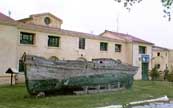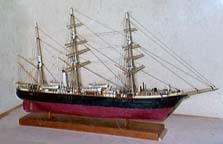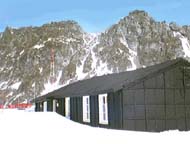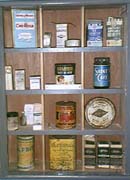Two 'furthest south' museums (and a stone hut and a burying ground as well).
Episode: 71.
Site Numbers: 419, 423, 424, 425.
Date Posted: 17 February 1999.
Location: Ushuaia, Argentina; Laurie Island, South Orkneys.
Type: Museums, Hut, Cemetery.
Four recently visited museums are certainly among the furthest south anywhere: Museo Maritimo de Ushuaia (Maritime Museum of Ushuaia) and Casa Moneta at Argentina's Orcadas Base in the South Orkneys (the subjects of this Episode) and the South Georgia Whaling Museum at Grytviken and the Falklands Islands Museum in Stanley (my focus next time).

 Ushuaia, on Tierra del Fuego's Beagle Channel, is an interesting and active port frequented by a number of Antarctic tour operators. Several shops sell penguin T-shirts and the like. But time was short and it was blowing a gale during my visit so I headed straight for what I had been told was the most important 'low-latitude' site there, the Museo Maritimo de Ushuaia or Maritime Museum of Ushuaia (419). It's at the eastern edge of the town within the military base, El Presidio. The Museum highlights Fuegian local history including convict life (the Museum is located in what was a jail and some of the displays are in the former cells). Exhibited are penguins, a fur seal skin (a bit worse for wear) and photos and captions on various aspects of the history of Antarctic exploration. Somehow I missed them but there are some Nordenskjöld artifacts from Snow Hill Island on display in several of the cells. [William Mills tells me there are more Nordenskjöld artifacts, this time from Hope Bay, in a glass case at the Officina Antartida on the waterfront, unfortunately closed during my visit. There are more still at the American Museum of Natural History (see Episode 44).]
Ushuaia, on Tierra del Fuego's Beagle Channel, is an interesting and active port frequented by a number of Antarctic tour operators. Several shops sell penguin T-shirts and the like. But time was short and it was blowing a gale during my visit so I headed straight for what I had been told was the most important 'low-latitude' site there, the Museo Maritimo de Ushuaia or Maritime Museum of Ushuaia (419). It's at the eastern edge of the town within the military base, El Presidio. The Museum highlights Fuegian local history including convict life (the Museum is located in what was a jail and some of the displays are in the former cells). Exhibited are penguins, a fur seal skin (a bit worse for wear) and photos and captions on various aspects of the history of Antarctic exploration. Somehow I missed them but there are some Nordenskjöld artifacts from Snow Hill Island on display in several of the cells. [William Mills tells me there are more Nordenskjöld artifacts, this time from Hope Bay, in a glass case at the Officina Antartida on the waterfront, unfortunately closed during my visit. There are more still at the American Museum of Natural History (see Episode 44).]
The two most interesting collections are the ships models and a large philatelic exhibit. I know of no comparable collection of detailed models of ships famous in Antarctic exploration, all crafted at a scale of 1/100 by Mirón Gonik. Among those included are Amundsen's Fram; Scott's Discovery (pictured here); Charcot's Le Français and Pourquoi-Pas?; and Argentina's Uruguay which rescued Nordenskjöld in 1903 and relieved Bruce's party in 1904. Perhaps the Endurance, Terra Nova, et al, will join the collection in the future. On the upper floor is a "relax zone" and shop. The Museum's website is at
http://www.tierradelfuego.org.ar/museomar.
The furthest south museum in this episode is in the South Orkneys on Laurie Island. It's at Argentina's Orcadas Base which has the distinction of being the oldest continuously operated research facility in Antarctica. Originally established in 1903 during
William Bruce's Scottish National Antarctic Expedition (the remains of the stone wintering-over hut--Omond House (425)--are still evident), the site was turned over to Argentina at the conclusion of the expedition. In a single story, dark-colored frame building--the sign at the entrance reads "Casa Moneta 1905"--is the museum (423),


contained in three rooms. One is done up as a replica of an early hut interior, another houses a biological collection, and the last contains a variety of artifacts. Among the items I noticed were: stuffed Adélie and Gentoo penguins, petrels, cormorants and a large skua hanging from the ceiling; sets of skis; life rings, anchors and such; food tins; photographs and maps; shotgun cartridges found near Omond House; and the remains of a packing case with stenciled markings from Bruce's expedition.
On the beach at Jessie Bay to the north of the base is a cemetery (424) containing seven graves, built up with stones and most marked by wood crosses. The most recent one is 1959 (Walter Soto); the earliest is for Allan Ramsay who died on August 6, 1903. He was first engineer of the Scotia, Bruce's ship. The mountain rising behind is named for him.

Update 20 March 2000: On return visits to the Museo Maritimo de Ushuaia between November 1999 and January 2000, I found some of the exhibits I had missed before: A radio room from the Almirante Brown station; a display of Nordenskjöld Snow Hill fossils and a reconstruction of the refuge shelter at Hope Bay; a file, spoon, teapot, enamel bowls and plates, an end of a wood packing case, nails, enamel dipper, flare stick, photography equipment, etc. all from Snow Hill. An exhibit is now being prepared on Gerlache and the "Belgica" expedition.

 Ushuaia, on Tierra del Fuego's Beagle Channel, is an interesting and active port frequented by a number of Antarctic tour operators. Several shops sell penguin T-shirts and the like. But time was short and it was blowing a gale during my visit so I headed straight for what I had been told was the most important 'low-latitude' site there, the Museo Maritimo de Ushuaia or Maritime Museum of Ushuaia (419). It's at the eastern edge of the town within the military base, El Presidio. The Museum highlights Fuegian local history including convict life (the Museum is located in what was a jail and some of the displays are in the former cells). Exhibited are penguins, a fur seal skin (a bit worse for wear) and photos and captions on various aspects of the history of Antarctic exploration. Somehow I missed them but there are some Nordenskjöld artifacts from Snow Hill Island on display in several of the cells. [William Mills tells me there are more Nordenskjöld artifacts, this time from Hope Bay, in a glass case at the Officina Antartida on the waterfront, unfortunately closed during my visit. There are more still at the American Museum of Natural History (see Episode 44).]
Ushuaia, on Tierra del Fuego's Beagle Channel, is an interesting and active port frequented by a number of Antarctic tour operators. Several shops sell penguin T-shirts and the like. But time was short and it was blowing a gale during my visit so I headed straight for what I had been told was the most important 'low-latitude' site there, the Museo Maritimo de Ushuaia or Maritime Museum of Ushuaia (419). It's at the eastern edge of the town within the military base, El Presidio. The Museum highlights Fuegian local history including convict life (the Museum is located in what was a jail and some of the displays are in the former cells). Exhibited are penguins, a fur seal skin (a bit worse for wear) and photos and captions on various aspects of the history of Antarctic exploration. Somehow I missed them but there are some Nordenskjöld artifacts from Snow Hill Island on display in several of the cells. [William Mills tells me there are more Nordenskjöld artifacts, this time from Hope Bay, in a glass case at the Officina Antartida on the waterfront, unfortunately closed during my visit. There are more still at the American Museum of Natural History (see Episode 44).]


